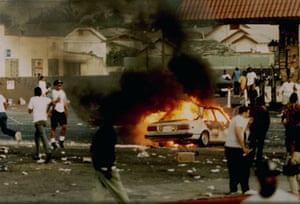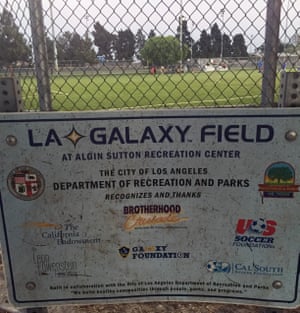South Los Angeles is a 51 sq m grille of concrete and asphalt, spread flat below the sparkle of Hollywood and the towers of downtown. Early city leaders wrote racist covenants forcing black people and Latino immigrants into the blocks of south LA – not-so-subtly barricading them from the opulence beyond.
Twice in the last 52 years, south LA has exploded into days of fiery riots following incidents of police brutality. The most recent, in 1992, erupted at the intersection of Florence and Normandie Avenues, roughly the area’s geographic centre, after the police beating of an unarmed man, Rodney King, was captured on video. The riots lasted for nearly a week, leading to 12,000 arrests and exposing the world to LA’s complex and violent tangle of gangs, who still patrol much of the area today.
Less than two miles from this fateful intersection sits the Algin Sutton Recreation Center. From the air, it is like a tiny, almost imperceptible square of green in south LA’s uniform grey. For years, Algin Sutton was a magnet for gangs. According to police maps, seven gangs – including LA’s largest, the 18th Street gang – claim the area as their own. The park’s main feature, a giant field ostensibly set up for soccer, was a pit of dirt, gravel and broken glass.
“Imagine a boat with a hole in it, that’s what that park was – a big hole in the boat,” says George Weaver, the program director at Brotherhood Crusade, an organisation dedicated to helping the underserved in south LA. “Someone had to figure out how to fix the [park’s] community so the community could thrive.”
Weaver, however, did not think he was the one to fix it. It was 2012, and he and Ed Foster Simeon, head of the US Soccer Foundation (USSF), were casting about for a place to test an unusual hypothesis: could soccer stabilise a volatile neighbourhood?
Algin Sutton, with its threadbare pitch and violent history, seemed too big a risk. Its empty baseball field and basketball court, built by well-meaning local professional teams, stood as broken reminders of previous attempts at revival.

Then a boy appeared. He was no more than 10 or 12, Foster Simeon recalls, and approached them.
“Are you here to do something about the soccer field?” Weaver remembers the boy asking. “We’ve been waiting.”
Foster Simeon and Weaver looked at each other they knew they had found their place.
For the next year, the pair worked to build that soccer field. They got some help: the USSF, along with the Major League Soccer club LA Galaxy, contributed $200,000 (£149,000); Brotherhood Crusade came up with another $600,000. By 2014, a full-size turf field had been constructed, along with metal bleachers, a fence and rows of stadium lights.
But instead of simply laying turf and slapping a sign on the pole, they also implemented the USSF’s youth soccer curriculum, called Soccer for Success. A free, two-hour after-school program, it involves coaches teaching skills and mentoring children in small groups.

They hired and trained coaches, and bought uniforms and workout equipment. Brotherhood Crusade opened a summer school, offered tutorial services for classwork, ran classes about nutrition and even provided free healthcare for their families through the nearby St John’s Hospital.
“Some people just want to build a soccer field,” Weaver says. “What we are trying to do is build more than a soccer field. We are trying to build a community.”
On the day of the opening, something strange happened: the gangs stayed away. It was as if the new soccer field – filled every afternoon with coaches and kids – had created an invisible barrier. Algin Sutton had become a place they decided to leave alone.
Weaver says they told the older gang members that he and the soccer foundation weren’t trying to drive the gangs away. Rather, they were trying to build a refuge – one where everybody, including the gang members’ families, could feel safe. He says they understood and respected the goal to create something good in their neighbourhood.
He remembers the moment he knew he had succeeded. It came one afternoon as he sat behind two women watching their children play. One mother had a Pirus street gang tattoo, the other had markings of the Hoover Criminals. By gang code, he says, they shouldn’t have been in the same park, let alone sitting side by side at a soccer game. Yet the field had suspended those edicts.
“In gangs you can’t be caught slipping,” Weaver says. “You can’t be caught in the wrong neighbourhood. But for their kid …”
In a city like LA, which is only 30% white, there are many neighbourhoods like the one around Algin Sutton that lack places for African American kids to play soccer.
The USSF tries to solve this problem by building smaller “futsal” fields in urban areas, and using their Soccer for Success program to introduce kids from underserved communities to the sport. Foster Simeon’s belief is that if kids in these neighbourhoods start playing soccer, the game will thrive in their communities much the way it has in wealthier areas. His partnership with Weaver is unique because Brotherhood doesn’t run sports programs. But, he says, “when they saw the curriculums and the outcomes we were getting they understood. All they care about is helping the kids.”

The conditions that led to the 1992 riots remain, he says. South LA remains a depressed desert in a booming city. Three-quarters of its residents are considered low income. Investment is sparse.
“Their story is very much tied to the 1992 riots,” Weaver says of the local community. “It’s a big deal to have a field built at Algin Sutton. They build fields every day in the suburbs, but not here. All we are doing is helping young people understand that they have value too.”
One recent evening, Weaver stood at the north end of his field and smiled. The park, once overrun with gangs, was alive. The field’s lights blazed bright. Two local teams of Latino teenagers played on the turf. Behind him the basketball courts and jungle gyms were packed. Families lingered on the pavement. Two women sat behind a card table selling cookies. A man sold ice cream from a makeshift cart attached to a bicycle.
“This is actually the only park in this section of the city, which is why the gangs used to come here,” says one of the youth coaches, Leo Hill. “Now the gang activity has just dropped. I think they saw there was a different crowd here. I guess the park was so nice they didn’t want to mess it up.”
This is part three of our in-depth look at soccer and race in American cities – catch up on part one and part two.
Follow Guardian Cities on Twitter, Facebook and Instagram to join the discussion, and